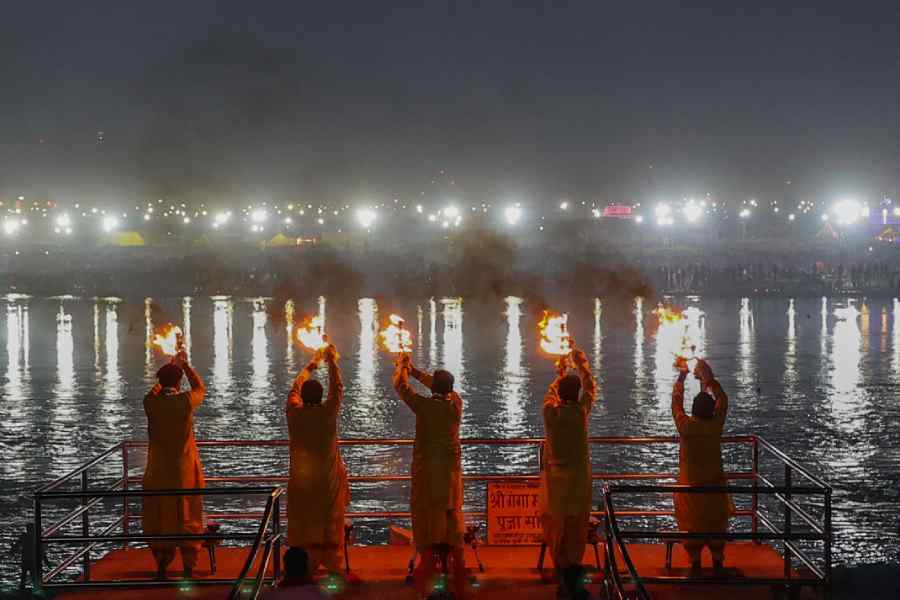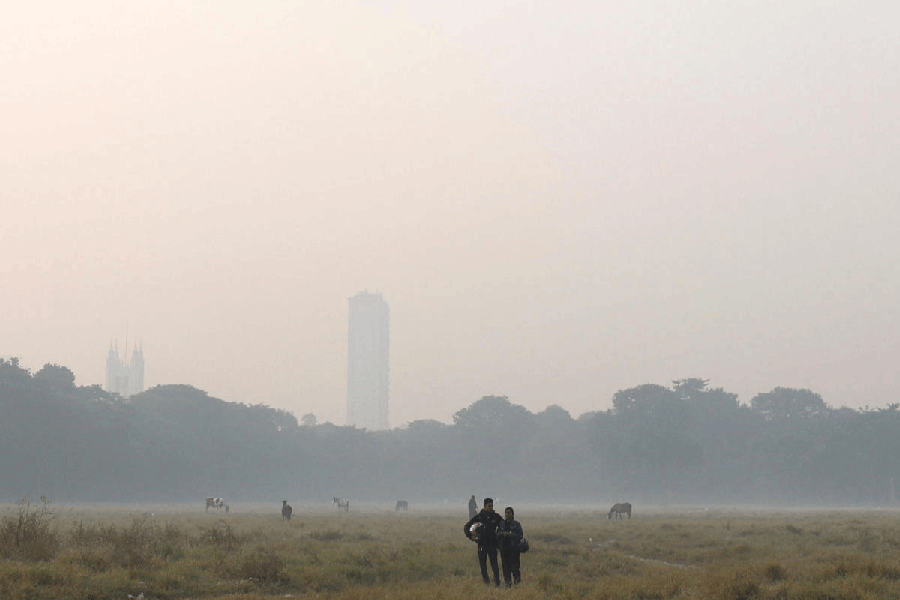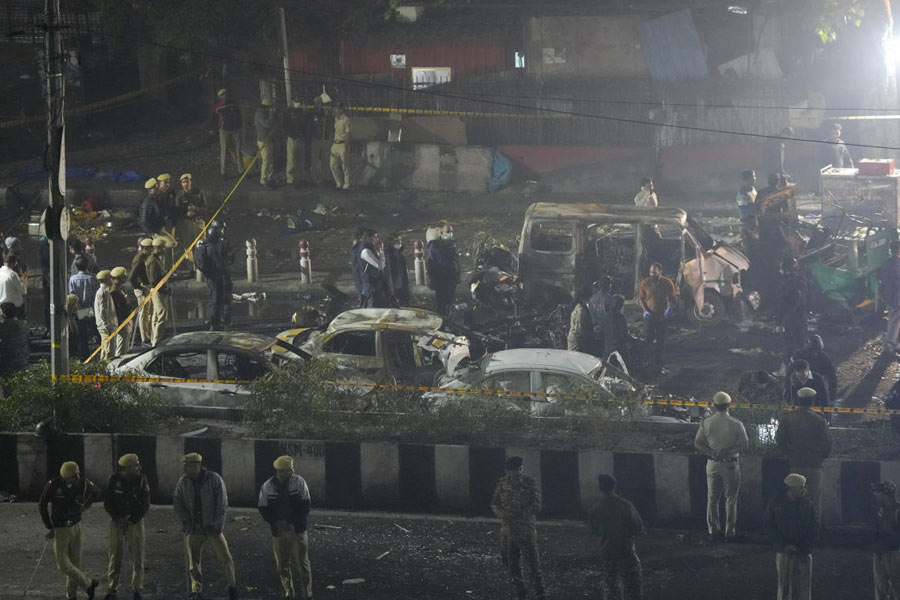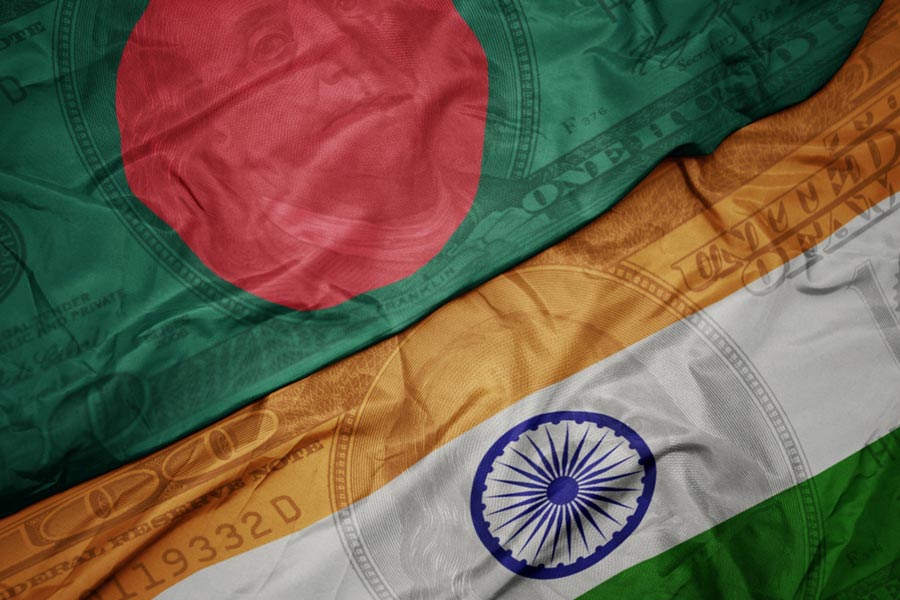Amidst the euphoria about the Mahakumbh, which commenced mid-January, an insight compels us to reason with a historical question. How much does the Kumbh conceal in the revelations that hog the electronic, print and social media? Arguably, the Kumbh that is associated with the mythological sagar manthan — the churning of the ocean by gods and demons — demands from us a further churning in our understanding. The Kumbh, this piece argues, has been an orientalist object from time immemorial.
The orientalism of the Kumbh derives from the sacred mythological tales inscribed in the ancient texts, astrological determination, and the various stakeholders in it. An exceptionally enigmatic, astrological, celestial conjunction called kumbhyog occurs once in 12 years. In ancient times, there were 12 such astrological occasions but they have now been restricted to only four according to celestial and astrological calculations. The four Kumbhs are held at an interval of 12 years at Prayag, Haridwar, Ujjain and Nasik during the lunar month of Magh. A purna Kumbh that occurs after a total of 12 purna Kumbhs — after 144 years — is deemed to be a Mahakumbh.
But the Mahakumbh of 2025 is not just about scriptural and astrological injunctions. As the reels and shorts on social media reveal, it is also about a new orientalism. In the images of an IITian baba, a former actress taking to an ascetic role, the cabinet of a state government and India’s political bigwigs bathing at the sangam, there is a reaffirmation of the exotic, a rise of neo-orientalism.
A modern historian such as Kama MacLean reflected on the colonial and the post-colonial popularity of the Kumbh saying, “Kumbh Mela was applied to Allahabad’s extant Magh Mela in the 1860s by Prayagwals (river pandas, priests) of Prayag (Allahabad) working upon and within the limits imposed by the colonial state and its discourses.” The colonial conceptions of Hindu sanatan dharma and its associated festivals were deeply informed by the orientalist imagination. This depicted India in the double register of awe and horror, a Hegelian object of desire as well as a Hobbesian object of disorder. The Kumbh is a concrete manifestation of this double register of orientalism. The enchanting exoticism of the Kumbh centralises the mythological tales, practices of penance and renunciation, varieties of asceticism, the akhadas and sadhus. But it also amounts to a fear of disorder that had compelled various regimes of power in history to put a system of surveillance and control.
Reporting on the 1989 Kumbh at Prayag, the well-known BBC correspondent, Mark Tully, navigated the kaleidoscopic unfolding of the Kumbh. He saw the ascetics and the pilgrims called Kalpvasis; he noted the presence of the Brahmins known as Prayagwals, the boatmen called Kewats and the lower caste called Khatiks; Tully also witnessed a famous sage named Devraha Baba supporting the then Ram Janmabhoomi movement. Yet Tully resorted to an orientalist notion while remarking that the Hindus gathered at the Kumbh were symbolic of a “religion beyond the reality of history, a religion of the imagination which goes beyond reason.”
The orientalism of the Kumbh puts a gloss over the caste configurations that are most vivid in the structure of the Kumbh congregation. To subdue the presence of caste in the Kumbh, there are numerous references to ancient texts, which, in turn, superimpose the mythological sagar manthan over the social history of the Kumbh.
This mystical halo that can be traced back to textual references overpowers historical tidbits as well. The Chinese Buddhist scholar and traveller, Hsüan Tsang, appears to have expressed awe about the Kumbh in the 7th century CE in which the emperor of Kannauj, Harshavardhan, participated and performed charity. Abul Fazal’s Akbarnama is also mentioned as a source to show the appreciation of the Mughal emperor, Akbar, for the Kumbh mela. Apparently, he witnessed the pilgrims’ practices at the sangam in 1574, renamed Prayag as “Ilahabas or Allahabad” (City of God), and had a fort built by the bank of the river.
Adding to the perpetual orientalism are the formidable statistics on the number of participants and the scale of the organisation of the Kumbh that result in jaw-dropping visuals even from the satellite of the Indian Space Research Organisation. The UNESCO had also declared the Kumbh as an intangible heritage of India in 2017, adding more momentum to the historical orientalism.
In his book, Bharat Me Kumbh, Dhananjay Chopra has duly depicted the Kumbh as a microcosm of India. The point to note is that this microcosm is like Indian society, organised along the lines of caste, class, and gender. The Kumbh’s caste configurations are palpable. Claimed to be the custodians of the Kumbh, the Prayagwal Brahmins own the genealogies of the pilgrims. The Ghatiyas who officiate rituals at the bank of the sangam are more like working-class priests dealing with the nuts and the bolts on the ground. But Ghatiyas rank above the Kewats and the Khatiks in the Kumbh’s caste pyramid. Kewats, also called Mallahs or Naviks, are the boatmen who ferry the pilgrims across the rivers and take them to the middle of the sangam to perform rituals. Many from the Kewat community have also started driving autorickshaws that pick up and drop pilgrims in Prayag. Khatiks are traditionally associated with the cleaning of dirt. Many of them are still part of the teams devoted to cleaning the banks around the sangam. Besides, pilgrims never leave the caste networks through which they arrive at the Kumbh.
M.K. Gandhi had a critical comprehension of the Kumbh. He made note of the orthodoxy and the inequality inherent in such religious congregations. And yet, in 1915, he attended the Kumbh at Haridwar with due admiration for the religiosity and the austerity. The medieval saint-poet, Kabir, lent a poetic dimension to the sarcasm about the ritualistic behaviour of the pilgrims at the Kumbh. Kabir was courageous to be critical as well as dismissive of the hierarchy and the inequality. But the Kumbh found a space in the fond memories of Jawaharlal Nehru in his book, The Discovery of India, in which Nehru wondered, “What was the tremendous faith, I wondered, that had drawn our people for untold generations to this famous river of India”?
The sublime and the ridiculous come together in the cauldron of orientalism at the Kumbh. There are new additions to the spectacles of the Kumbh through youth and YouTubers with sleek gadgets creating reels and shorts. In this age of new fetishes, the Kumbh has become a promising ground for the manifold reincarnation of orientalism, thereby imposing blindfolds towards the ever-evolving caste configurations.
Dev Nath Pathak is Associate Professor of Sociology at South Asian University and is a member of the Mahakumbh review team of Indian Institute of Technology, Kanpur











